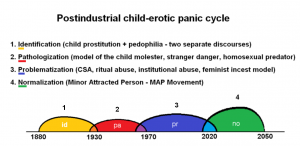Child Sexual Abuse
Child Sexual Abuse (CSA) is a taxonomic term used in academic literature to distinguish most minor-adult sex as a separate category with unique and innate harmful properties. It was popularized by American moral entrepreneurs and sexual abuse/trauma theorists of the late 1970s and early 80s. This influence, has since percolated throughout western culture, law, medicine and other sciences such as psychology. While modern CSA theory is arguably rooted in feminist critiques of power-difference, it also owes a lot to long-held conceptions of childhood as a unique and special period of life, and moral/religious views on sexuality as a topic which can be analyzed and governed through the lens of "valid" and "invalid" subtypes. Much of the early amplification of CSA-adjacent discourse can be ascribed to religious and moral entrepreneurs such as Judianne Densen-Gerber and Lawrence Padzer.[1]
Since the conception of CSA, a generalized moral panic has ensued, peaking with a variety of more specific mass hysterias (such as Satanic Ritual Abuse in the 80s/90s), and continuity themes (Institutional Child Sexual Abuse in the 00s and 10s). This moral panic is one of three distinguishable panics concerning adult-youth sexual contacts since the industrial revolution, and we are at the beginning of a fourth.
Sociological Background
As applied to Minor Attracted People (particularly pedophiles), CSA represents a key development in the late pathologization and early problematization stages of the problem-cycle:
1. Identification (turn of 19th/20th Century) > 2. Pathologization (20th Century, inc. postwar era) > 3. Problematization (explosion of discourses and taxonomies, late 70s+) > 4. Normalization (starting early 21st Century).
As each stage has corresponded roughly to a specific panic, this would seem to imply that we are due a moral panic over the normalization of pedophilia.
Empirical Invalidity
A large, but not yet critical number of experts now hold that the concept of CSA is empirically invalid and pseudoscientific. This view is also unsurprisingly held by a number of Minor Attracted People and is also sometimes expressed in a round-about way by laypersons - particularly those who lived long before contemporary CSA panics. This article will argue from such a position.
Orthodoxy
Notwithstanding the lack of scientific support for such a theory, CSA has attained the status of a monolithic belief system, or orthodoxy that may not be challenged, even by personal experiences contradicting its narrative. As well as causing pre and post-conditioned harms via social stigmatization and legal processing, the dangers of CSA as a belief system also extend to unprosecuted sexual interactions believed to be consensual and non-traumatic when they took place. Consider for example, a person - male or female, who had a voluntary contact with an older person at the age of 12, and is now an adult. In most western cultures, they are left with two options:
- 1. Stay silent, and assimilate society's shame, as their experiences are deemed to have been invalid.
- 2. Speak out, only to incur the full wrath of a shameful society expressing its insecurity by casting them as a victim, liar or heretic. All at the risk of incriminating their ex-partner.
Despite a complete lack of proof for a causative chain in the harms supposedly intrinsic to CSA, and evidence of widespread neutral and positive recall of events deemed to be abusive, official bodies and lawmakers continue to irresponsibly perpetuate the associated social stigmas and harms under the proviso of protecting the vulnerable.
Theoretical hubris
CSA is used to describe nearly all sexual activity between adults and considerably younger minors; that is to say it has "universality" in both the subject matter it describes and the characteristics it ascribes to said subject matter. According to some American psychiatrists, even activities such as being naked in the presence of a child (deemed normative in some parts of Europe and the non-western world) are counted as abusive.
CSA is (sometimes) distinguished from rape by its "manipulative" and/or recurring nature. In other words, whilst rape is generally considered to be a violent act of forceful sex, child sexual abuse, when distinguished from rape, is considered to be an ongoing series of unwanted sexual interactions gained through manipulation or grooming - forms of subtle coercion ranging from flattery through emotional blackmail, to bribes. However, most academia and legal systems are prone to describing any age-disparate sexual activity below a certain age as rape. This tendency is similar to the idea of statutory rape (as applied to older teens), but in this case the acts are held to be ethically indistinguishable from one another - and thus the concept of all such activity as rape or assault becomes an axiom. This blurring of language has also infected the media, professional bodies and NGOs.
As a result, any distinctions in the usage of the term (historically more clearly demarcated) have in the last few decades become increasingly blurred. For example, when reading a generic local news report, it is no longer possible to be sure what kind of "abusive" acts actually took place - leaving the reader to speculate as to the horrors described as sexual assault, or indeed rape. With the victim-oriented feminist and lesbian push to blur the lines between violent rape, "date rape", "statutory rape" and even regretted encounters during the eighties and following decades, many people now sadly use terms such as "child sexual abuse", "child molestation", "pedophilia" and "rape" interchangeably.
Opponents of this blurring of boundaries argue that lumping these categories together undermines severe abuse and punishes misdemeanor/non-abusive acts, thus doing a disservice to parties with a range of experiences, from the positive, thru the forgettable, to the profoundly traumatic. Indeed, despite the actual definition and literal implications of the term "abuse", very rarely is the issue of consent or coercion relevant to the term's modern use. That is to say, given the assumption that no child is capable of consenting to sexual activity, any instance of sex with a child is considered child sexual abuse, regardless whether or not the child consented, desired or even sought the act.

Timeline of a panic
- See: Moral panic.
The broader moral panic surrounding behaviors now defined as CSA took place in four distinct phases. In the Victorian Era and following decades, panic set in around the purity of young girls, with crackdowns on prostitution. While not highly influential at the time, the sciences started the process of pathologizing and categorizing deviant forms of sexuality. Then between the 30s and 50s, the state focused on the sexual psychopath and stepped up its legal efforts against homosexuals and gender nonconformists. From the mid-70s, children took center stage - in a phase of problematization that remains partly in effect. From around 2020, a fourth phase began, concerning the normalization of the "Minor Attracted Person" and his purported modes of deviance.
Is there real CSA?
It can not be denied that some seriously harmful acts do involve both coercion and genital contact, so in essence, they are both sexual (in the conventional, erogenous sense) and abusive. However, as already explained, stigma/iatrogenesis is the source of all harms exceeding intrinsic physical and psychological traumas, meaning the "CSA category" is in essence a completely unwarranted "nativization" of cultural baggage. As repeatedly identified by Bruce Rind, erotophobia and antisexualism (morality) is assimilated into the scientific and public discourse, resulting in a series of absurd pseudo-objective ethical circulars. These circular arguments live-real, as a series of self-fulfilling prophecies such as the consenting juvenile (often a female) who goes on to earnestly believe she is a victim of rape, due to misogynistic sex stigma. It is perhaps this unfortunate circumstance that is best described as real sexual abuse, since the resulting moral conflicts are capitalized upon by power-hungry elites and special-interest lobbies, at the expense of a person's capacity to feel erotic pleasure.
Debunking CSA as a concept
- Bruce Rind is perhaps the one researcher who has statistically challenged the concept of CSA[2] with a thorough, controlled analysis of its assumed characteristics and their relationships with one another.
See also
- Research - A portal containing many references on CSA.
- David Finkelhor - A key proponent of CSA as a concept (and axiom).
- List of obfuscatory terms used by authorities
- Child Pornography - Laws and research on the true nature of Child Pornography are linked.
- Minor-adult sex
External Links
- CSA - Wikipedia presents a victimological perspective.
- John Henley in The Guardian - Paedophilia: bringing dark desires to light - Distinguishes Pedophilia from CSA and challenges the outcomes of CSA.
